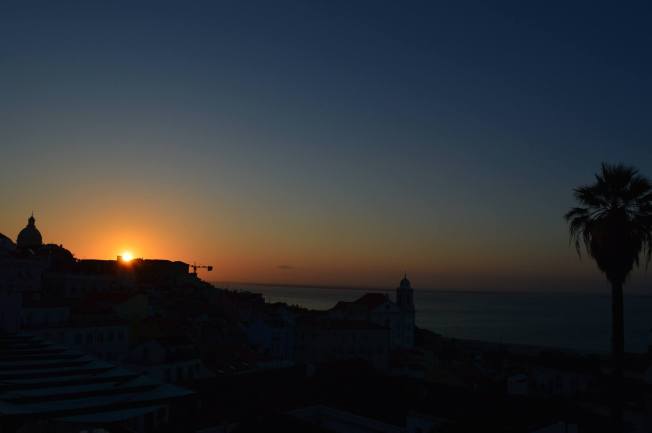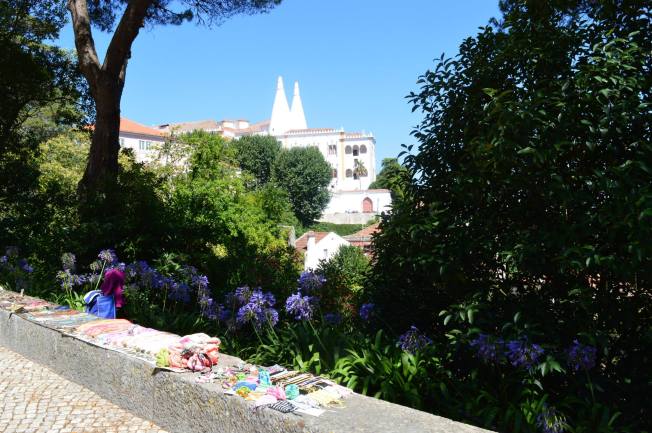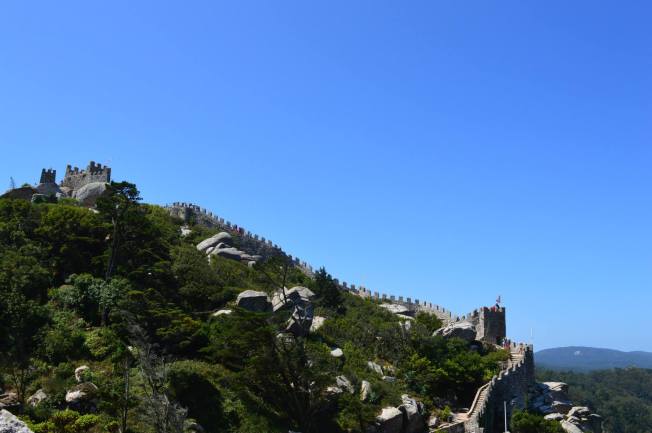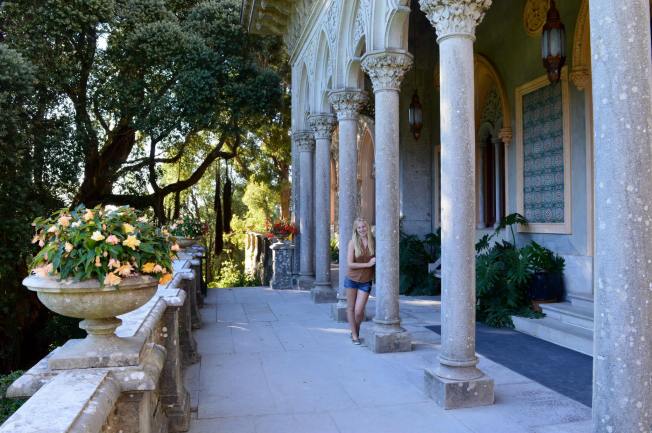Few times have I experienced walking around a city in the early hours of the morning with a relaxed sense of security. No need to look over my shoulder with suspicion, to shiver into a jacket with a sudden cold rush, or feel like I was trespassing the silent empty streets at an unsaintly hour. The sun rises sleepily into the soft sky as one ambles down St. Lucia in the Alfama district of Lisbon towards the Rua de Augusta. Here waiters set up tables on the street to get ready to serve breakfast to the many tourists that will swarm this street later on. I walked into Patisserie Brasileira to buy a cinnamon pastry and ate it on the steps of King João I in the Praça de Comércio. It suddenly hit me that it was the 1st of August and I pinch-punched myself to commemorate a new month.

Today I would be heading west towards the town of Sintra with Virág, the Hungarian girl I met on the bus down from Porto. This plan of travelling with someone else had arisen only the late evening before and I wasn’t sure what to expect. What advantages and disadvantages would having company bring?
The statues in the water fountains in Rossio were still dozing in the dawn as I walked towards the train station, which I had heard could be pretty sketchy. A return ticket cost 4.80Euros and as I headed towards the barriers, a man suddenly called for us to hurry – the train was about to depart. Assuming he was correct, I hurried through the barriers with him straight behind, only to realise soon after that he had been using us to get on the train without a ticket…
A 40 minute journey away by train, Sintra is famed for its fairy-tale castles and palaces, many of which are classed as UNESCO World Heritage Sites. First however we planned to visit Cabo da Roca which is the westernmost point of continental Europe. Bus 403 will take you the 18km from Sintra station to the cape, with a hop-on-hop-off ticket costing 12Euros. Prepare for an entertaining journey. The bus driver would navigate up steep roads and around countless hairpin bends whilst occasionally holding his phone to his ear. Every time we ascended a narrow street and an approaching car suddenly came into view, I would suck in my tummy tightly. We wound our way past lush green rainforests and through towns with large fruit markets and elderly residents chatting on café corners before arriving at the windy coast. Here the ‘land ends and the sea begins’,* the vast ocean of blue sending rippling waves crashing against the rocks. (*Luís de Camões – one of Portugal’s most highly-regarded poets)

I quickly noticed differences between myself and Virág. I descended the sandy, rocky terrain downwards at a quick pace without giving too much thought to where I was putting my feet; she walked with more caution. She was keen to see as many palaces as possible; I was wary of spending too much money on admission fees. I was happy to walk to most places for exercise, but Virág preferred to take the bus. Virág seemed to want us to agree on the tiniest things, such as whether to go left or right, whereas this constant confirmation made things a little too rigid for my liking. She wanted to have a hot meal for lunch; I said I normally snack on cold eats when travelling.
Back in Sintra, we walked towards the town centre, passing a display of crafts laid out on top of the pavement wall with the pillars of the National Palace poking up in the background. There are various bus stops in the centre from where the 12Euro ticket can be used for most routes.

The Castelo dos Mouros (Castle of the Moors) was built by Muslims in the 8th Century as a base from which to check the Atlantic ocean for incoming invaders, before coming under Christian control in the 12th Century. Hold on tight (especially to your stomach) as the 434 bus zig-zags around more hairpin bends for 3km to reach it. Costing 8Euros to get in, the castle has been reconstructed in the 20th Century, but as you squeeze up narrow stairways before dropping down into little dens, you can easily imagine soldiers crouching down to protect themselves from armed attack. Over its rigid stone walls you’ll see great views of the surrounding countryside (but more so on the right-side.)
The National Palace of Pena is classed as a 1.5km walk from the castle, but feels like less. Don’t let the uphill gradient put you off, as you’ll likely find that by the time the bus arrives, you would have reached it by foot. Being the most popular of the palaces, this one cost 14Euros to go all the way inside. I found myself in an unfamiliar position where I had to explain my budget to someone else, and with me feeling restricted, we agreed to pay the lower fee of 10.50 for access to the grounds and onto the terrace only, although I soon learned that this was perfectly adequate. Built in 1840 as the holiday destination for the Portuguese monarchy, the palace strikes as quite gaudy with its vibrant mix of bright colours and patterned tiles. But even if it’s too kitschy for your liking, it’s still worth a look and you can’t help but be impressed by the effort that has gone into building and maintaining it.
It was while walking through the park with its various nooks and crannies that I began to realise that actually, Virág and I were more similar than I thought. Just like first impressions of the palace’s exterior might be that it is over-the-top in its appearance, I learned that Virág had more appeal to me than at first believed. We had interesting conversations and seemed to have similar outlooks towards certain issues. It made me smile when, after a moment of silence during which I began to feel grateful for her company, Virág said “I’m glad we met on that bus from Porto.”
I found during the day that I was rubbing off on Virág, and likewise she was rubbing off on me. At one point she agreed to walk instead of take the bus, and I was persuaded to choose a hot option for lunch. A great place to eat in Sintra is at Xentra. ‘Free buffet – 8.50’ may look deceiving, but you’d be amazed at how great the value is. Drinks are priced separately but for the main, you can choose to have as much as you want of salad, chorizo sausage, chicken, pork in white wine, fried squid and bacalhau (a cake of cod, potato and white sauce), while for dessert there is the traditional treat of Serradura – whipped cream mixed with a ‘sawdust’ of crushed biscuit. You won’t need to eat for the rest of the day.
Virág was keen to see another palace and feeling content with my stuffed stomach, I was no longer feeling frugal. We took the smaller bus 435 to Monserrate Palace which is situated a twisty 3.5km from the town centre. After paying the 8Euro entry fee and walking along the dusty path towards the entrance, I became mesmerised by the view ahead. The palace evokes an ‘Arabian Nights’ feel alongside hints of a mansion in British India, and when I saw a wedding reception take place outside, I longed to wear a pretty dress instead of my scruffy denim shorts and trainers. Pastel pink marble pillars lined a corridor underneath an intricately decorated ceiling. In the circular music room with a grand piano I could imagine the happy couple waltzing to their first song. The stone terrace looked out over a sprawling lawn that led to a majestic oasis of botanical gardens. We explored this exotic maze hearing only the sounds of trickling water and bird song. I felt even more like I’d entered the Garden of Eden when we encountered a hippy trio singing and banging a soft drum. It almost seemed inappropriate that we were all wearing clothes…



I envied the little girls in their white bridesmaid dresses because they must have felt like princesses here. This palace was everything a palace should be – authentic, classy, elegant, pure and sophisticated, but small and subtle at the same time. Everything looked so pretty, catching the late afternoon light so perfectly, that I found myself constantly getting my camera out, no longer caring that the battery was getting very low. We had definitely saved the best till last. But was it not for having company, I might not have seen it.
The day had definitely reminded me to be more open-minded when it comes to sight-seeing with other solo travellers abroad. Listening and taking into consideration the interests of a new companion had been a valuable experience. It had highlighted that two minds can be better than one. With some people, one day of their company travelling around would be sufficient, but I found myself wanting to also spend the next day with Virág too. It was not that I had suddenly lost all desire to travel alone, but I was more inclined towards the idea of giving spontaneous companionship a chance.
I walked back to my hostel from Rossio station with map-less ease, feeling more comforted and confident in the knowledge that I had the option of sharing my experience of Lisbon with a new friend.
*
Would you like to take this article with you on the road? You can download a GPS version to your iPad or iPhone by following this link. Thank you for reading and happy travels!
Read the final chapter from Lisbon in Lazy Sundays in Lisbon




Pingback: Escape to Portugal – Loyalty and Loneliness in Lisbon | soleseeking
It’s King João I, and Patisserie “Brasileira” (Brazilian) 🙂
Thank you for the correction!